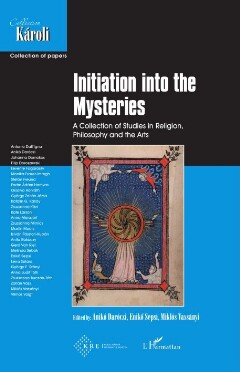Page 203 [203]
INITIATION INTO MYSTERIES IN PIco’s WORKS
for if we will to, we can. Let us spurn earthly things; let us struggle toward
the heavenly. Let us put in last place whatever is of the world; and let us fly
beyond the chambers of the world to the chamber nearest the most lofty
divinity.”"? Pico refers here, by word, to the mysteries that can show us what
kinds of beings are near the divinity: “There, as the sacred mysteries reveal,
the seraphim, cherubim and thrones occupy the first places.”* Our aim has
to be to reach the same position: “Ignorant of how to yield to them [...] let us
compete with the angels in dignity and glory.”* In Pico’s opinion, success is
guaranteed if we really want it: “When we have willed it, we shall not be at all
below them."" His next question is, what method should we choose? What
should we do to reach this place? He suggests that we have to see what they
are doing, what kinds of lives they are living, and we have to do so in order
that we may then be equal with them. The source of the following description
about the angels’ features has to be Pseudo-Dionysius’ Celestial Hierarchy,
and Pico subsequently quotes Pseudo-Dionysius by name”: “The seraph burns
with the fire of charity; the cherub shines with the radiance of intelligence;
the throne stands in steadfastness of judgement.”®
Translating these tasks or conditions into human possibilities, he says that,
just as there are three different types of angels, so we have three choices too:
one is the active life, taking care of other beings below us and thereby showing
the steadfastness and justice of the thrones. Another is contemplation for
those who are tired from having led an active life. Through their meditation,
they will be able to see the creator in the creation and the creation in the
creator, and thus they will radiate with cherubic light. The third is charity:
“If we burn with love for the Creator only, his consuming fire will quickly
transform us into the flaming likeness of the Seraphim.”!? Pico does not
explain this in detail, but presumably loving the Creator also includes loving
the creation for the same reason that the contemplator will see the creator
in the creation and vice versa: because, at a lower level, the cherubim (that
is the contemplator), whose characteristic is radiance, have the capacity and
the knowledge of seeing the creator and the creation in each other as though
they were one, which is the sign of being enlightened. Book IV of Ficino’s
13 Pico Della Mirandola, On the Dignity of Man, 7. Translation by Wallis, Miller and Carmichael.
14 Ibidem.
55 Ibidem.
16 Ibidem.
Like Ficino, Pico did not discuss the authenticity of the authorship, so he quoted the author
by the name of Dionysius the Areopagite. See below.
15 Ibidem.
Caponigri’s translation. In Latin: “Si ab actionibus feriati, in opificio opificem, in opifice
opificium mediantes, in contemplandi otio negotiabimur, luce cherubica undique
corruscabimus. Si caritate ipsum opificem solum ardebimus, illius igne, qui edax est, in
saraphicam effigiem repente flammabimur.” Pico Della Mirandola, De hominis dignitate,
110.
+ 201 ¢
Daréczi-Sepsi-Vassänyi_Initiation_155x240.indb 201 6 2020.06.15. 11:04:20

